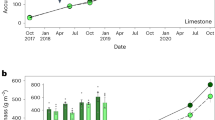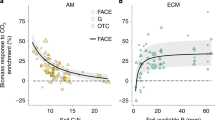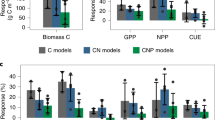Abstract
Terrestrial ecosystems gain carbon through photosynthesis and lose it mostly in the form of carbon dioxide (CO2). The extent to which the biosphere can act as a buffer against rising atmospheric CO2 concentration in global climate change projections remains uncertain at the present stage1,2,3,4. Biogeochemical theory predicts that soil nitrogen (N) scarcity may limit natural ecosystem response to elevated CO2 concentration, diminishing the CO2-fertilization effect on terrestrial plant productivity in unmanaged ecosystems3,4,5,6,7. Recent models have incorporated such carbon–nitrogen interactions and suggest that anthropogenic N sources could help sustain the future CO2-fertilization effect8,9. However, conclusive demonstration that added N enhances plant productivity in response to CO2-fertilization in natural ecosystems remains elusive. Here we manipulated atmospheric CO2 concentration and soil N availability in a herbaceous brackish wetland where plant community composition is dominated by a C3 sedge and C4 grasses, and is capable of responding rapidly to environmental change10. We found that N addition enhanced the CO2-stimulation of plant productivity in the first year of a multi-year experiment, indicating N-limitation of the CO2 response. But we also found that N addition strongly promotes the encroachment of C4 plant species that respond less strongly to elevated CO2 concentrations. Overall, we found that the observed shift in the plant community composition ultimately suppresses the CO2-stimulation of plant productivity by the third and fourth years. Although extensive research has shown that global change factors such as elevated CO2 concentrations and N pollution affect plant species differently11,12,13 and that they may drive plant community changes14,15,16,17, we demonstrate that plant community shifts can act as a feedback effect that alters the whole ecosystem response to elevated CO2 concentrations. Moreover, we suggest that trade-offs between the abilities of plant taxa to respond positively to different perturbations may constrain natural ecosystem response to global change.
This is a preview of subscription content, access via your institution
Access options
Subscribe to this journal
Receive 51 print issues and online access
$199.00 per year
only $3.90 per issue
Buy this article
- Purchase on Springer Link
- Instant access to full article PDF
Prices may be subject to local taxes which are calculated during checkout



Similar content being viewed by others
References
Denman, K. L. et al. in Climate Change 2007: The Physical Science Basis. Contribution of Working Group I to the Fourth Assessment Report of the Intergovernmental Panel on Climate Change (eds Solomon, S. et al.) (Cambridge University Press, 2007)
Luo, Y. Q. Terrestrial carbon-cycle feedback to climate warming. Annu. Rev. Ecol. Evol. Syst. 38, 683–712 (2007)
Reich, P. B., Hungate, B. A. & Luo, Y. Q. Carbon-nitrogen interactions in terrestrial ecosystems in response to rising atmospheric carbon dioxide. Annu. Rev. Ecol. Evol. Syst. 37, 611–636 (2006)
Hungate, B. A., Dukes, J. S., Shaw, M. R., Luo, Y. Q. & Field, C. B. Nitrogen and climate change. Science 302, 1512–1513 (2003)
Oren, R. et al. Soil fertility limits carbon sequestration by forest ecosystems in a CO2-enriched atmosphere. Nature 411, 469–472 (2001)
Reich, P. B. et al. Nitrogen limitation constrains sustainability of ecosystem response to CO2 . Nature 440, 922–925 (2006)
Luo, Y. et al. Progressive nitrogen limitation of ecosystem responses to rising atmospheric carbon dioxide. Bioscience 54, 731–739 (2004)
Sokolov, A. P. et al. Consequences of considering carbon-nitrogen interactions on the feedbacks between climate and the terrestrial carbon cycle. J. Clim. 21, 3776–3796 (2008)
Thornton, P. E. et al. Carbon-nitrogen interactions regulate climate-carbon cycle feedbacks: results from an atmosphere-ocean general circulation model. Biogeosci. Discuss. 6, 3303–3354 (2009)
Langley, J. A., Mckee, K. L., Cahoon, D. R., Cherry, J. A. & Megonigal, J. P. Elevated CO2 stimulates marsh elevation gain, counterbalancing sea level rise. Proc. Natl Acad. Sci. USA 106, 6182–6186 (2009)
Ainsworth, E. A. & Long, S. P. What have we learned from 15 years of free-air CO2 enrichment (FACE)? A meta-analytic review of the responses of photosynthesis, canopy properties and plant production to rising CO2 . New Phytol. 165, 351–371 (2005)
Jablonski, L. M., Wang, X. Z. & Curtis, P. S. Plant reproduction under elevated CO2 conditions: a meta-analysis of reports on 79 crop and wild species. New Phytol. 156, 9–26 (2002)
Xia, J. Y. & Wan, S. Q. Global response patterns of terrestrial plant species to nitrogen addition. New Phytol. 179, 428–439 (2008)
Reich, P. B. et al. Do species and functional groups differ in acquisition and use of C, N and water under varying atmospheric CO2 and N availability regimes? A field test with 16 grassland species. New Phytol. 150, 435–448 (2001)
Reich, P. B. Elevated CO2 reduces losses of plant diversity caused by nitrogen deposition. Science 326, 1399–1402 (2009)
Erickson, J. E., Megonigal, J. P., Peresta, G. & Drake, B. G. Salinity and sea level mediate elevated CO2 effects on C3-C4 plant interactions and tissue nitrogen in a Chesapeake Bay tidal wetland. Glob. Change Biol. 13, 202–215 (2007)
Zavaleta, E. S. et al. Grassland responses to three years of elevated temperature, CO2, precipitation, and N deposition. Ecol. Monogr. 73, 585–604 (2003)
Schneider, M. K. et al. Ten years of free-air CO2 enrichment altered the mobilization of N from soil in Lolium perenne L. swards. Glob. Change Biol. 10, 1377–1388 (2004)
Dukes, J. S. et al. Responses of grassland production to single and multiple global environmental changes. PLoS Biol. 3, 1829–1837 (2005)
Hooper, D. U. & Vitousek, P. M. The effects of plant composition and diversity on ecosystem processes. Science 277, 1302–1305 (1997)
Craine, J. M. et al. The role of plant species in biomass production and response to elevated CO2 and N. Ecol. Lett. 6, 623–630 (2003)
Levine, J. M., Brewer, J. S. & Bertness, M. D. Nutrients, competition and plant zonation in a New England salt marsh. J. Ecol. 86, 285–292 (1998)
Pennings, S. C. et al. Do individual plant species show predictable responses to nitrogen addition across multiple experiments? Oikos 110, 547–555 (2005)
Tilman, D. Plant Strategies and the Dynamics and Structure of Plant Communities (Princeton University Press, 1988)
Craine, J. M. Resource Strategies of Wild Plants (Princeton University Press, 2009)
Reynolds, H. L. & Pacala, S. W. An analytical treatment of root-to-shoot ratio and plant competition for soil nutrient and light. Am. Nat. 141, 51–70 (1993)
Keller, J., Wolf, A., Weisenhorn, P., Drake, B. & Megonigal, J. Elevated CO2 affects porewater chemistry in a brackish marsh. Biogeochemistry 96, 101–117 (2009)
de Graaff, M. A., van Groenigen, K. J., Six, J., Hungate, B. & van Kessel, C. Interactions between plant growth and soil nutrient cycling under elevated CO2: a meta-analysis. Glob. Change Biol. 12, 2077–2091 (2006)
Chapman, S. K., Langley, J. A., Hart, S. C. & Koch, G. W. Plants actively control nitrogen cycling: uncorking the microbial bottleneck. New Phytol. 169, 27–34 (2006)
Smith, M. D., Knapp, A. K. & Collins, S. L. A framework for assessing ecosystem dynamics in response to chronic resource alterations induced by global change. Ecology 90, 3279–3289 (2009)
Acknowledgements
We acknowledge the support of D. Cahoon, our primary US Geological Survey collaborator, who co-developed the experimental design of this study. We thank J. Duls, J. Keller, M. Sigrist, G. Peresta, B. Drake, E. Sage, A. Martin, D. McKinley, N. Mudd and K. White for the construction and maintenance of the field site at the Smithsonian Climate Change Facility. We appreciate comments from S. Chapman, A. Classen, J. Hines, B. Hungate, T. Mozdzer, A. Sutton-Grier and D. Whigham. The field study was supported by the USGS Global Change Research Program (cooperative agreement 06ERAG0011), the US Department of Energy (grant DE-FG02-97ER62458), the US Department of Energy’s Office of Science (BER) through the Coastal Center of the National Institute of Climate Change Research at Tulane University, and the Smithsonian Institution.
Author information
Authors and Affiliations
Contributions
Both J.A.L. and J.P.M. designed the experiment, interpreted the data and wrote the paper.
Corresponding author
Ethics declarations
Competing interests
The authors declare no competing financial interests.
Supplementary information
Supplementary Information
This file contains Supplementary Figure 1 with legend, Supplementary Methods and References. (PDF 743 kb)
Rights and permissions
About this article
Cite this article
Langley, J., Megonigal, J. Ecosystem response to elevated CO2 levels limited by nitrogen-induced plant species shift. Nature 466, 96–99 (2010). https://doi.org/10.1038/nature09176
Received:
Accepted:
Issue Date:
DOI: https://doi.org/10.1038/nature09176
This article is cited by
-
Reproductive Responses to Increased Shoot Density and Global Change Drivers in a Widespread Clonal Wetland Species, Schoenoplectus americanus
Estuaries and Coasts (2024)
-
Oxygen priming induced by elevated CO2 reduces carbon accumulation and methane emissions in coastal wetlands
Nature Geoscience (2023)
-
Geomorphic and ecological constraints on the coastal carbon sink
Nature Reviews Earth & Environment (2023)
-
Simple Machine Learning with Aerial Imagery Reveals Severe Loss of a Salt Marsh Foundation Species
Estuaries and Coasts (2023)
-
Will free-living microbial community composition drive biogeochemical responses to global change?
Biogeochemistry (2023)
Comments
By submitting a comment you agree to abide by our Terms and Community Guidelines. If you find something abusive or that does not comply with our terms or guidelines please flag it as inappropriate.



